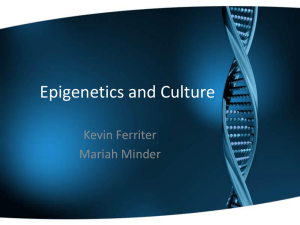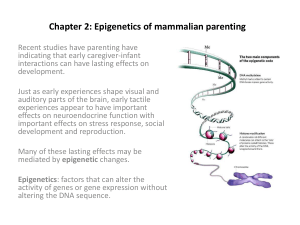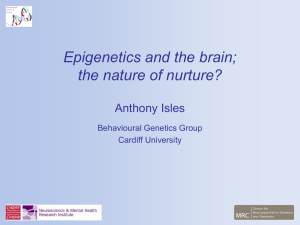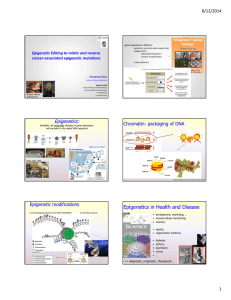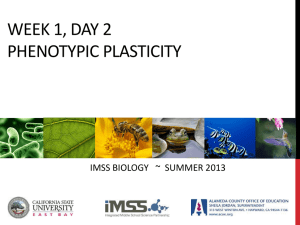LessonPlan-The Dutch Hunger Winter Story
advertisement
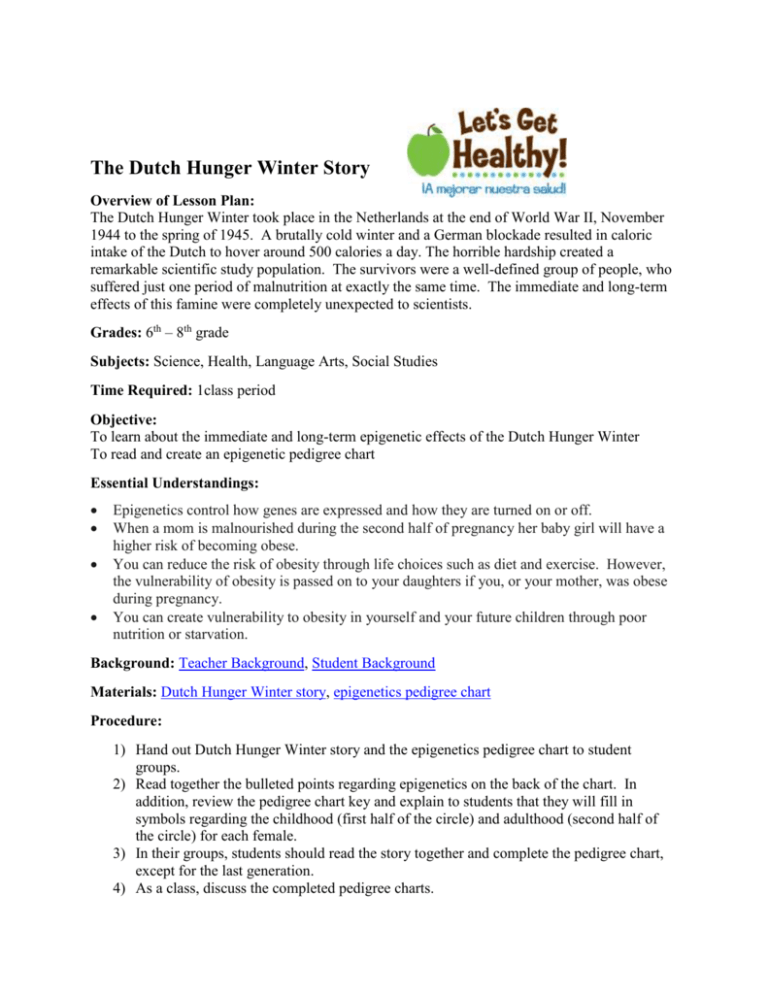
The Dutch Hunger Winter Story Overview of Lesson Plan: The Dutch Hunger Winter took place in the Netherlands at the end of World War II, November 1944 to the spring of 1945. A brutally cold winter and a German blockade resulted in caloric intake of the Dutch to hover around 500 calories a day. The horrible hardship created a remarkable scientific study population. The survivors were a well-defined group of people, who suffered just one period of malnutrition at exactly the same time. The immediate and long-term effects of this famine were completely unexpected to scientists. Grades: 6th – 8th grade Subjects: Science, Health, Language Arts, Social Studies Time Required: 1class period Objective: To learn about the immediate and long-term epigenetic effects of the Dutch Hunger Winter To read and create an epigenetic pedigree chart Essential Understandings: Epigenetics control how genes are expressed and how they are turned on or off. When a mom is malnourished during the second half of pregnancy her baby girl will have a higher risk of becoming obese. You can reduce the risk of obesity through life choices such as diet and exercise. However, the vulnerability of obesity is passed on to your daughters if you, or your mother, was obese during pregnancy. You can create vulnerability to obesity in yourself and your future children through poor nutrition or starvation. Background: Teacher Background, Student Background Materials: Dutch Hunger Winter story, epigenetics pedigree chart Procedure: 1) Hand out Dutch Hunger Winter story and the epigenetics pedigree chart to student groups. 2) Read together the bulleted points regarding epigenetics on the back of the chart. In addition, review the pedigree chart key and explain to students that they will fill in symbols regarding the childhood (first half of the circle) and adulthood (second half of the circle) for each female. 3) In their groups, students should read the story together and complete the pedigree chart, except for the last generation. 4) As a class, discuss the completed pedigree charts. 5) Individually, each student should fill in the adult epigenetics of the two fourth generation females. Reflection (optional): Students can select one of the two fourth generation females and write a short biography. How was her body impacted by the lives of her great-grandmother, grandmother, and mother? How has her body been impacted by her own choices regarding diet and exercise? The Dutch Hunger Winter The following is a fictional story based on the Dutch Hunger Winter and the resulting trans-generational epigenetic study. The Dutch Hunger Winter transpired during the end of World War II, November 1944 to the spring of 1945, under Nazi controlled Netherlands. Characters: Audrey (b. 1920) Pre Nov. 1944 = normal weight, post Nov. 1944 = under weight Elizabeth (b. July 1943) Normal weight at birth Mary (b. October 1945) Normal weight at birth, vulnerable to obesity Christine (b. 1970) Normal weight at birth, poor health habits super athlete Jennifer (b. 1970) Normal weight at birth, vulnerable to obesity, The Story I remember the day so clearly. I was upstairs trying to get ready for school. My mother was at the bottom of the stairs, yelling at me to hurry up or I’d miss the bus. Our dog was barking wildly in the backyard, chasing shadows of the spring. I stood before my mirror, a heap of clothes and shoes lingering behind me. Nothing, and I mean nothing, in my closet fit, looked right, cute, appropriate, anything. I sucked in my gut and pleaded my way into a size 16 pair of jeans. My gut sank. “Jennifer, honey, you need to hurry it up,” my mother said, as she entered my room. She paused, leaned against the wall, and let her heavy breathing return to normal. Her eyes met mine, like she was holding a mirror up. “You don’t want to miss your cousin Christine getting crowned as prom queen.” My heart sank at hearing Christine’s name. She was beautiful, popular, head cheerleader, and, yes, dated the captain of the football team. She was known for her generosity – always willing to share the chips or candy she carried around. Why wasn’t I more like my cousin, I was often asked. Unfortunately for me, I could take up two seats on an airplane, had no athletic abilities, had personally talked to a total of two guys – when they had asked for directions, and went to the same school as my cousin. My mother held out a stack of leather-bound books. “I found some of your grandmother’s diaries down in the basement. I thought they could be a nice addition to your family history project.” I took them from her, wiping away the dust and cobwebs, and opened the top one. On the inside was an inscription to my Grandma Audrey dated August 1942. Over the next two days I read my grandmother’s story from being a twenty-two year old in 1942 through the birth of her grandchildren in 1970. It was a story that changed my life, made me understand why I was who I was. My grandmother was born in Amsterdam, capital of the Netherlands, in 1920. The sepia pictures dotting her journals showed my grandmother to be a stylish and elegant woman with a delicately lovely bone structure. Absolutely gorgeous. A pang of jealousy touched me as I thought of the genes my cousin Christine must have inherited from our grandmother. As the years passed, the clouds of World War II began to darken her diary entries. However, even as she wrote of the war newsreels she watched before viewing Hollywood movies, she talked about her growing family, including the birth of my Aunt Elizabeth in the summer of 1943. Life was not easy but my grandmother was able to provide all that any child would want – plenty of food, toys, and a warm bed at night. All that changed for my mother and her home country in the fall of 1944. The Dutch Hunger Winter lasted from November 1944 to late spring of 1945. A bitterly cold winter and a German blockade led to a catastrophic drop in the availability of food to the Dutch population. The normal daily intake became 500 calories, less than a third of what it used to be. My grandmother would wander the streets in search of food such as grass and tulip bulbs. Her family no longer had any furniture since they had burned everything in order to stay warm. During this time more than 20,000 people died. And then, after the food supplies were restored, my mother was born. According to my grandmother, my mother was a normal-sized, happy baby. She was a miracle beyond all miracles. As a child, alongside her older sister, she ran through the streets with the other neighborhood children, jumped rope, and played hopscotch. Unlike my aunt, by the time my mother was a teenager, she was being teased for her weight. She had blown up like Violet Beauregarde of Charlie and the Chocolate Factory. My mother and I had led parallel lives. I thought about my normal sized cousin as I read curiously about my aunt, who had apparently been a ballet star during her formative years and remained healthy throughout her life. The last diary entry, in the back of the smallest book wrapped with a leather cord, described the day of my birth. I too was a normal-sized, happy baby. Decades later, as I rounded the last corner my five-mile run, I flashed back to that day. The day when my mother had given me the gift of family history and when I learned that a famine my grandmother endured had shaped my own body. It turned out that the famine happened early in my mother’s development and that, incredibly, had influenced which of my genes were turned on and off – including those that regulate how my body uses and stores energy. But now I know that it’s not just my genes, but also my environment and my choices that make all the difference. Unlike my cousin, whose poor eating habits caught up to her as she cried into her plus size wedding dress, many years of a healthy lifestyle – long runs, whole foods, low stress, lots of sleep, tons of water - have brought me to this point where I now see in the mirror the healthy woman my grandmother had once been. My grandmother would have been proud. The Dutch Hunger Story – An Epigenetic Tale of Fate & Choice As you listen to the Dutch Hunger Story use the following symbols to help you mark the pedigree chart. = Normal Male = Malnourished Female = Healthy Female = = Obese Female Vulnerable to obesity due to malnourishment in utero = Unknown Audrey Elizabeth Christine _______________ Mary Jennifer _______________ Biography of baby _____________________________________________________________________ ____________________________________________________________________________________ ____________________________________________________________________________________ ____________________________________________________________________________________ ____________________________________________________________________________________ ____________________________________________________________________________________ (to be copied onto the back of the pedigree chart) Essential Understandings Epigenetics control how genes are expressed and how they are turned on or off. When a mom is malnourished during the second half of pregnancy her baby girl will have a higher risk of becoming obese. You can reduce the risk of obesity through life choices such as diet and exercise. However, the vulnerability of obesity is passed on to your daughters if you, or your mother, was obese during pregnancy. You can create vulnerability to obesity in yourself and your future children through poor nutrition or starvation. (Teacher Key) The Dutch Hunger Story – An Epigenetic Tale of Fate & Choice As you listen to the Dutch Hunger Story use the following symbols to help you mark the pedigree chart. = Normal Male = Malnourished Female = Healthy Female = = Obese Female Vulnerable to obesity due to malnourishment in utero = Unknown Audrey Elizabeth Christine _________________ Mary Jennifer _________________ Student Background on Epigenetics Imagine for a moment you wrote a song that rivals (insert famous singer here) and it is going viral on the Internet. People love the impressive guitar solo, which proves you can swing like the heavy hitters of the rock world. You published the music and lyrics, but unfortunately you did not protect the rights to your song. Rock n roll wannabees are taking your song and doing their best to play like you do. The results are disastrous. Even though the tune is the same, the song sounds completely different from yours. You ask yourself, “How is this possible?!” The difference comes in the interpretation of the music. Even though a note may be the same on the page, the way a note is strummed, loud or soft, at a specific moment in the song can change the overall impression the song creates. This is one way artists distinguish themselves from amateurs. Artists know where to place the musical inflections to produce musically pleasing songs. Amateurs, on the other hand, lack the artistic abilities you posses so when they play your song, the result sounds more like cats calling. Now let’s see how music can relate to science. Interestingly, how DNA is expressed to create you is very similar to how music is played. Just like lyrics and music can be written on paper, but sound very different based on the person playing the song, DNA can be identical, but the DNA is “played” makes a difference in how your functions. Epigenetics study of how DNA is “played” and the subsequent results. song way is the To study epigenetics, scientists use model systems. Model systems could be as simple as a Petri dish of cells or as complex as an animal. Scientists choose the lowest possible model study in order to answer their questions. For example, scientists have studied bacteria, mice and even humans to understand the mechanisms of epigenetics. One such model are identical twins. Identical twins are studied because the DNA of identical twins is, as the word indicates, identical. From birth to age three, these twins are very similar in appearance and in their behaviors, but as they grow older, the similarities between the twins begin to differ in appearance, and can even differ in their overall health. Why are identical twins different if their DNA is identical? Scientists, suspecting epigenetics, set out to find the answer to this question. Watch the following NOVA ScienceNow video to see what they discovered: http://www.pbs.org/wgbh/nova/body/epigenetics.html Teacher Background on Epigenetics What is epigenetics Epigenetics is the study of the environment’s influence on our genes’ activity. DNA is often referred to as the blueprint or instruction manual for our bodies. DNA is the hardware, but epigenetics are the software. Epigenetics tell our bodies which section of the blueprint (or which page of the instruction manual) to read at a given time. Epigenetic changes do not alter the letters of our DNA, but instead change its punctuation – think like an exclamation point (!), bold, strikethrough, footnote, or comma (i.e. “Let's eat Grandpa.” this phrase with an epigenetic change might be “Let's eat, Grandpa”). Why is it important These “punctuation” changes can turn genes “on” or “off”, a process called gene regulation. Gene regulation is required for normal development throughout our lives. Genes that are expressed instruct cells what to become, how our organs form, how we remember material for a math test, how our bodies respond to disease and infection, and much, much more. Epigenetics is the study of how environmental factors impact gene regulation which controls gene expression. Gene regulation influences our health throughout our lifespan and new research is suggesting that epigenetic changes may extend across multiple generations to affect the health of our children, grandchildren, and possibly even great-grandchildren. Epigenetic changes are reversible, so our life choices may reverse or mitigate the effects of early epigenetic marks and prevent them from being transmitted to further generations. This is like playing a card game. Even if you are dealt a bad hand it is possible to play it well. It is also possible to mess up a good hand with the wrong life choices. This is an important concept for adolescents because it suggests that we aren’t just a product of our genes, but our environment and the choices that we make, too. We need to “nurture our nature”. How does it work? –– Molecular Mechanisms The mechanism of how epigenetics works is fascinating. Stretched end to end, our DNA is about 6 feet long (2 meters) and shoved into practically every cell in our bodies. It is shaped like a long ladder, twisted like a spiral staircase, then wrapped around proteins (histones) like string around spools (see diagram on next page). These wrappings (nucleosomes) are then further condensed into chromosomes. Think of our DNA like a set of encyclopedias where each chromosome is one of its volumes. If you want to “read” any of the instructions contained in one of these volumes, you need to “unfold” the DNA. Not all the DNA can be unwound at the same time, so only parts of the instructions can be accessed at any one time. Only 2-3% of our DNA is made up of genes. Genes are the instructions to make proteins (called gene expression) that make our body function. The remaining 97% of our DNA was previously thought to be “junk DNA” with no known function, though the Encyclopedia of DNA Elements Project (ENCODE) found in 2012 that at least 80% of our genome is active at some point during our lives and is likely involved with regulating gene activity. http://www.sciencelearn.org.nz/var/sciencelearn/storage/images/contexts/uniquely-me/scimedia/images/cell-chromosomes-and-dna/464336-1-eng-NZ/Cell-chromosomes-and-DNA.jpg Epigenetics works by ‘tagging’ or making punctuation changes to our DNA. Two of the best known mechanisms are: Histone acetylation -- DNA is wound around chemical spools called histones. This saves space in the cell, but tightly wrapped DNA can't be read for gene expression. Chemical triggers can attach an “acetyl group” to an external part of the spool core that causes the core to open the DNA and make it available to reading. Histone acetylation refers to more gene access. Histone deacetylation removes the acetyl group and closes the DNA, so less gene access. DNA Methylation -- In other cases, a methyl group can be added to the DNA to “tag” it. With several methyl groups added, machinery cannot access the DNA to read it and the resulting gene is not expressed. This serves as a chemical “skip this part”. Methyl tags can be added or removed throughout the lifespan by various environmental factors discussed below. Note: Research is constantly finding new epigenetic mechanisms. For example, histones can be methylated or acetylated in different loci for different functions. RNA was recently found to be methylatable, too. But, the general thought is the same. Epigenetics is all about turning gene activity up or down, on or off. How is a person impacted by epigenetics Epigenetics affects our bodies throughout our lives because gene expression occurs every day throughout our lifespan. The epigenetic effects on our health depend on when (in our development) and where (in our bodies) our genes are turned “on” and “off”. We have learned from historical famines and population-wide studies that long-term health effects can be observed following a variety of environmental exposures. Current research suggests that the following environmental factors can affect how our genes are regulated. Sun (ultraviolet light) Diet (methionine, choline, Pesticides Drinking water pollutants folate, B12) Metals (Ni, Cr, As, Cd, Hg) Auto exhaust Hormones (bisphenol A, Tobacco Smoke Radiation DES, estrogen, dioxins) Social interaction Fetal development The experience of a fetus in the womb is a critical time for affecting development and future disease risk. For example, our kidneys are normally formed in the womb between 33 and 36 weeks. We now understand that if diet, toxins or other environmental factors disrupt growth during that critical period, the kidney cells won’t form properly and health effects can be seen later in adulthood due to low-functioning kidneys. Kidney problems can also be seen earlier in childhood, depending on the extent of the disruption. Research is now finding that there are “developmental origins of disease”, where the surrounding environment of the growing baby can affect its susceptibility to chronic disease later in life. Adult risks for obesity, cardiovascular disease, diabetes and metabolic syndrome have been linked to these early fetal development periods. Interestingly birth weight seems to be predictive of this effect, where low birth weight babies have a higher risk of obesity later in life. Babies born around eight-nine pounds seem to have the lowest risk of future disease risk. The increased risk doesn't just happen in low birth weight babies but in high birth weight babies, which may not have had the right nutrients. This "over fed, undernourished" syndrome is a special concern and is currently being studied. We have learned that effects that occur during pregnancy may persist for generations because a female’s eggs are all developed during a short time that she is in her mother's womb. These eggs will become the sons and daughters of the baby girl. The nutrition during pregnancy can not only affect a woman's baby, but also her grandchildren. Men aren’t immune to this as new evidence is suggesting epigenetic effects may occur on the sperm as well. Early life epigenetics A newborn or toddler exposed to bis-phenol A (a chemical formerly used in plastic bottles and still used in the lining of tin cans) becomes vulnerable to obesity in later life. Research in rats has also shown that young rat pups groomed (licked) more frequently by their mothers had a better ability to handle stress as adults than pups groomed less frequently, a result of epigenetic control of glucocorticoid (stress) genes in the brain. Research is currently underway related to how other social interactions can affect our health – bullying, growing up with siblings, abuse, etc. A 2012 paper by Tung and colleagues showed that the dominance rank of rhesus macaques (a type of primate) was strongly associated with gene expression in their immune system, with the magnitude of gene expression actually predicting the macaques’ rank in their group over time. This effect hasn’t been explored in humans, though it highlights an important biological mechanism for how our physiology and health can interact. Epigenetics in later life It is fairly easy to see how something a person is exposed to might modify their epigenome. Identical twins have been used most frequently to study the long-term effects of the environment on our genes since they share the same DNA. When identical twins are young, their epigenetic tags are mostly the same. But as they age and experience different lives, their epigenetic tags are different (see image on right). Likewise, with our different environmental exposures as we age, current cancer research is looking at the epigenetic control of genes related to cell growth that may have been improperly turned “on” or “off” by the environment. Future research and unanswered questions http://learn.genetics.utah.edu/content/epigenetics/twin s/ There are bound to be many news stories about epigenetics in the next few years. It is important to consider the credibility of the sources of these stories. Carefully designed studies from respected institutions with a clear statement of the limitations of the investigation backed up through review of other scientists are more credible than extreme claims made through the popular press without details of how the investigation was conducted or reviewed. Especially suspicious are claims made in relation to products which claim to have health benefits through epigenetic effects. Other than general dietary recommendations, it is just too early to be able to manufacture such products. Such things will take a number of years of development and would be tested in carefully controlled studies. Currently, there is solid scientific evidence of epigenetic impacts on vulnerability to hypertension, kidney disease, obesity, type II diabetes, cholesterol problems, stroke, and osteoporosis. Under investigation are links between epigenetics and vulnerability to autism, depression, and schizophrenia. Right now, the best advice is to eat a healthy diet, sleep well, avoid stress, and avoid exposure to environmental toxins. All these are familiar bits of advice that your grandmother may have given you, but now we are beginning to understand the deep molecular biology for how they work and we will be able to use that understanding to give more specific epigenetic help. For more information on genetics or epigenetics, visit the Genetic Science Learning Center http://learn.genetics.utah.edu and http://teach.genetics.utah.edu Name ______________________________________________ Date _________ Period ________ Online Resources for Epigenetics VIDEO Title Source Link Epigenetics PBS - NOVA Epigenetics I and II PBS - NOVA (via youtube) Epigenetics scishow (via Youtube) Epigenetics makes you unique: Courtney Griffins at TEDxOU TEDxTALKS (via Youtube) (Audio slide show) A Tale of Two Mice PBS – NOVA ARTICLES Title Source http://www.pbs.org/wgbh/nova/body/epigenetics.html http://www.youtube.com/watch?v=wFsxVkuChdU (7: http://www.youtube.com/watch?v=Xjq5eEslJhw (6:19) http://www.youtube.com/watch?v=kp1bZEUgqVI&feature=youtube_gdata_player http://www.youtube.com/watch?v=JTBg6hqeuTg http://www.pbs.org/wgbh/nova/body/epigenetic-mice.html Audio slide show and supporting web page about the aguti mice and epigenetics. Link How the First Nine Months Shape the Rest of Your Life Time Magazine - By Annie Murphy Paul Why Your DNA Isn't Your Destiny. Time Magazine - By John Cloud http://www.time.com/time/magazine/article/0,9171,1952313,00.html Beyond DNA: Epigenetics Deciphering the link between nature and nurture. Natural History - By Nessa Carey http://www.naturalhistorymag.com/features/142195/beyond-dna-epigenetics Epigenetics: Tales of Adversity. Nature - International Weekly Journal of Science http://www.nature.com/nature/journal/v468/n7327_supp/full/468S20a.html WEB SITES Title Learn Genetics and Teach Genetics Source The University of Utah - Genetic Science Learning Center http://www.time.com/time/magazine/article/0,9171,2021065,00.html#ixzz2Wn5nO1wE Link http://learn.genetics.utah.edu/content/epigenetics/ Name ______________________________________________ Date _________ Period ________

